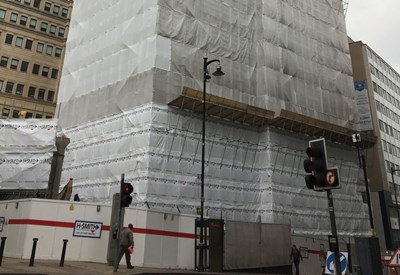SES designed and installed extensive and innovative scaffolding for the demolition of one of Birmingham's tallest buildings.
Occupying a prominent position in the most prestigious address in the city's business district, NatWest Tower had sat unused since 2003 until planning permission was granted for a new 35-storey modern office and retail building.
A confined city-centre environment
Principal contractor H Smith Engineers appointed SES to design and construct scaffold solutions to enable access for this complex project. The building was in a confined city-centre environment with numerous obstacles to overcome, including difficult access, podium roofs and adjacent property roofs. In addition, four basement levels required extensive back-propping solutions to allow a 250 feet high scaffold to be constructed to the office tower, positioned above adjacent pedestrian streets, busy city-centre roads and lower level roofs. The task was far from straight forward.
290 feet high scaffold with protection system
Heavy duty designed street gantries and protection fans were installed progressively at several levels as the scaffold was erected. In addition, SES designed and erected primary truss out beam work from high level floors to support secondary prefabricated beam spans over adjacent property roofs. The intensive scaffold leg loads clustered through trebled standards were transferred through the four basement levels. Installation of extensively designed back propping systems gave an overall scaffold height of just under 290 feet.
“A complex demolition project”
The H Smith Engineers Project Manager, who has many years’ experience with specialist demolition projects, commented, “This project is by far one of the most complex demolition works I have been involved in to date. The access works are one of the most difficult aspects to overcome. Having worked with SES we are grateful that they have brought us their vast scaffolding experience and their steadfast commitment to delivering the highest levels of service and quality, complemented by a safety culture that always supports their operations on site.”

